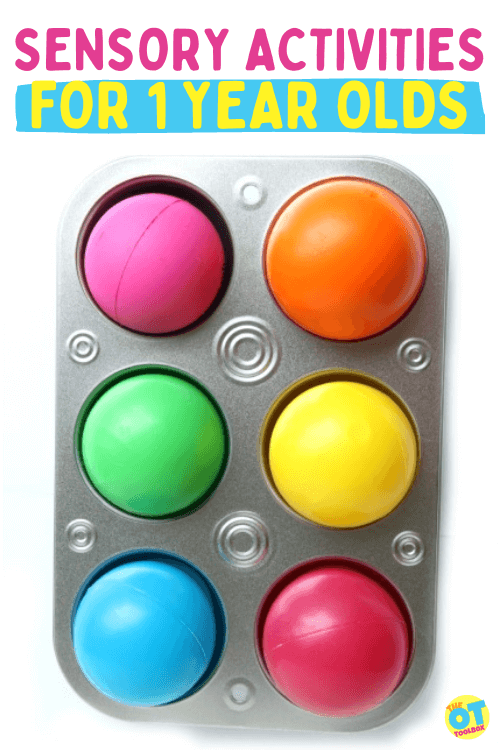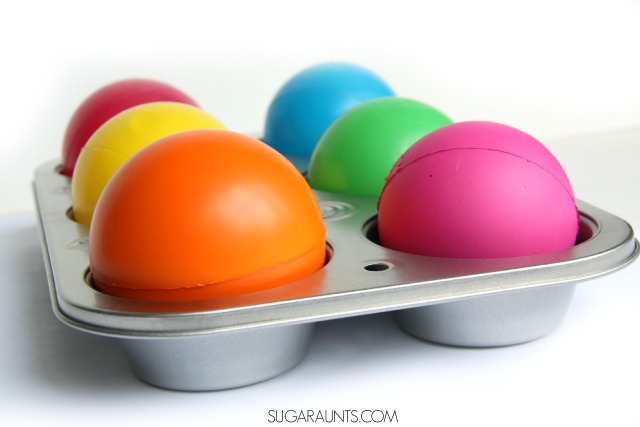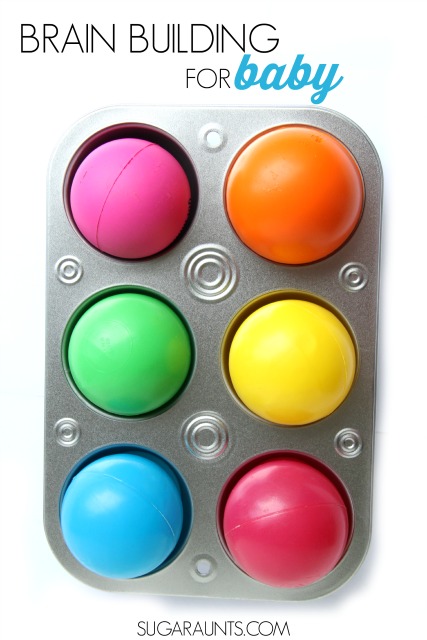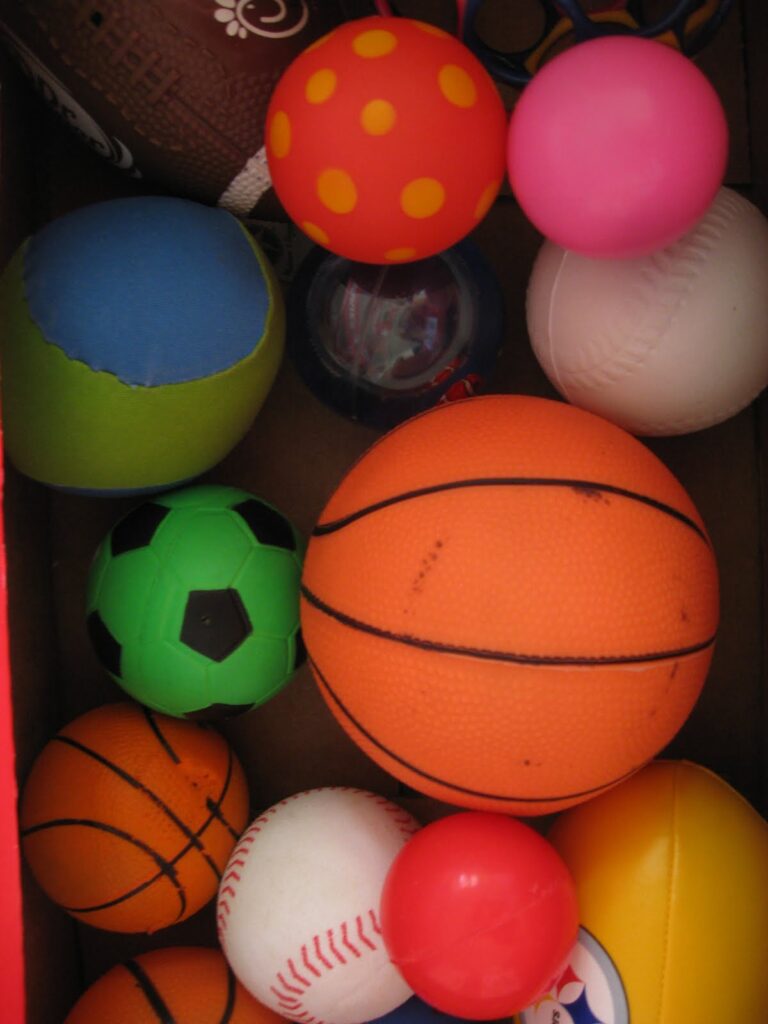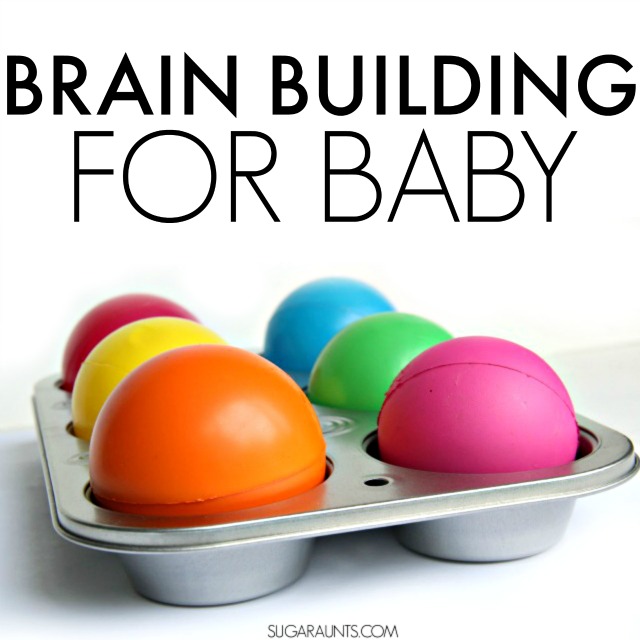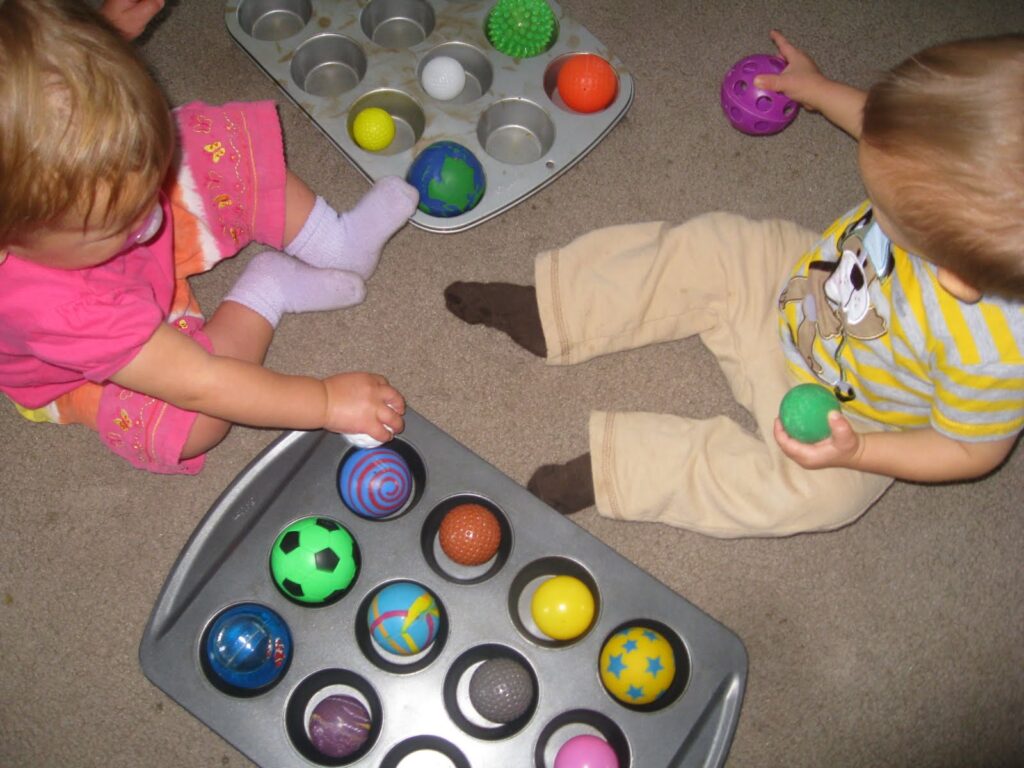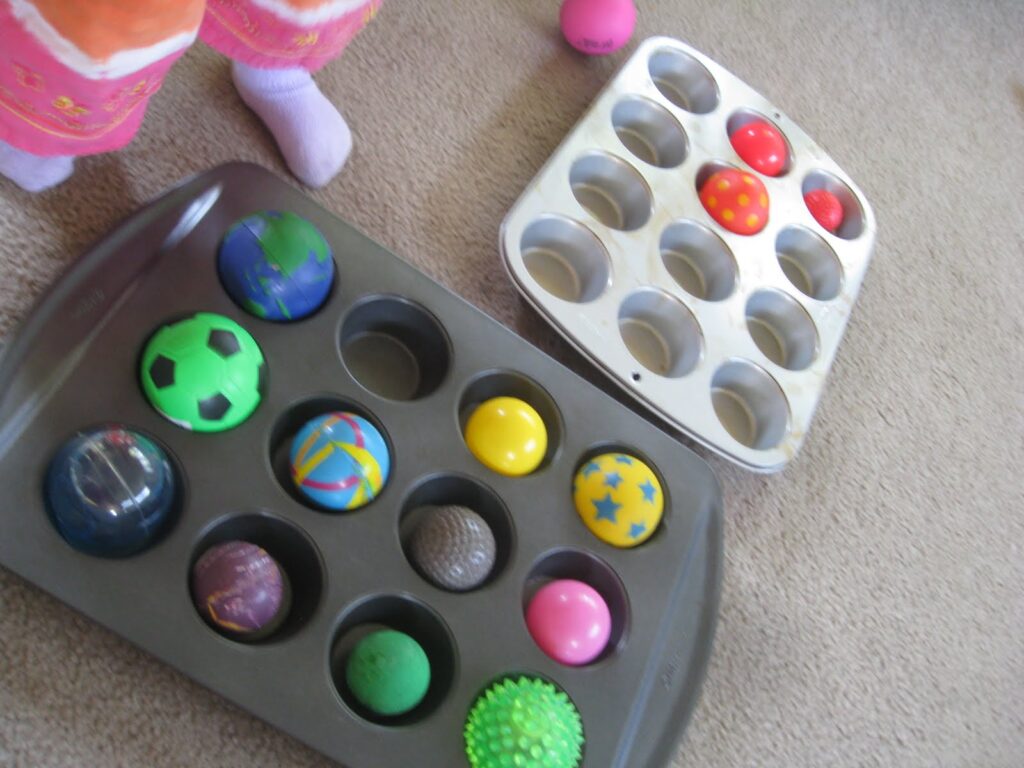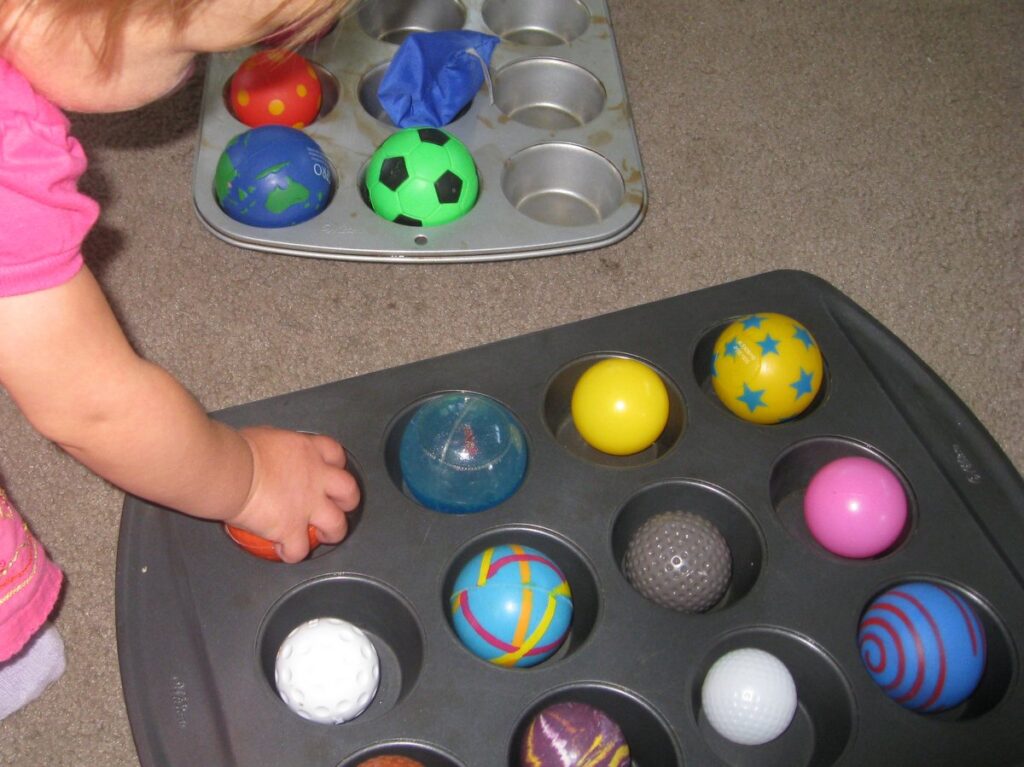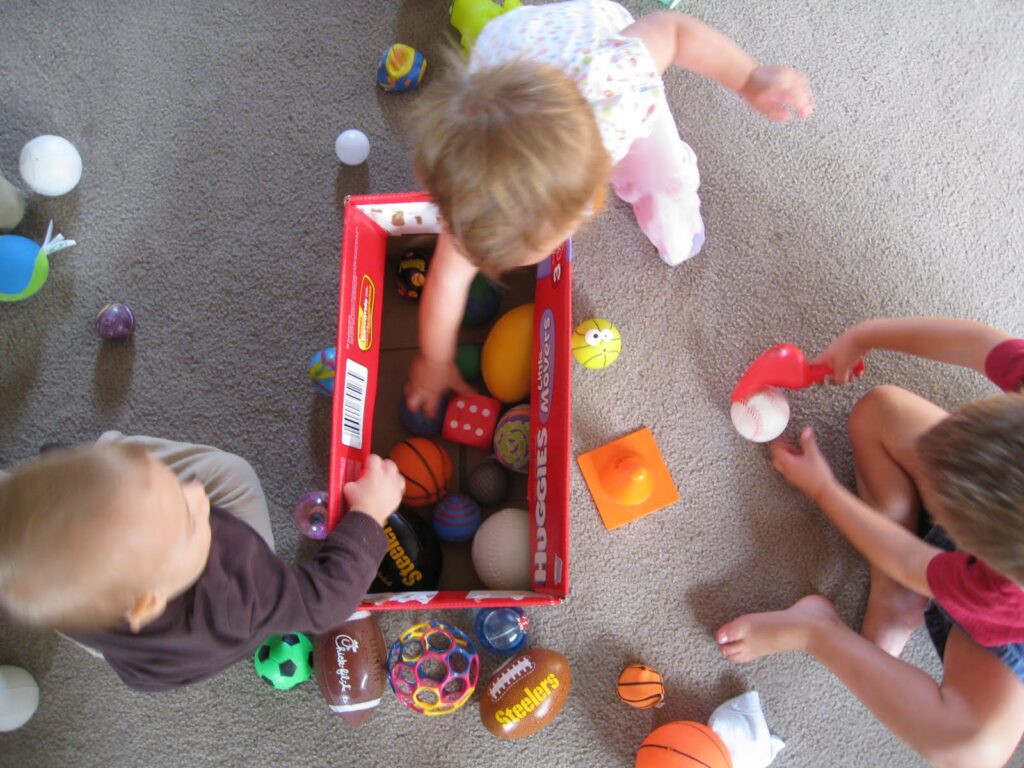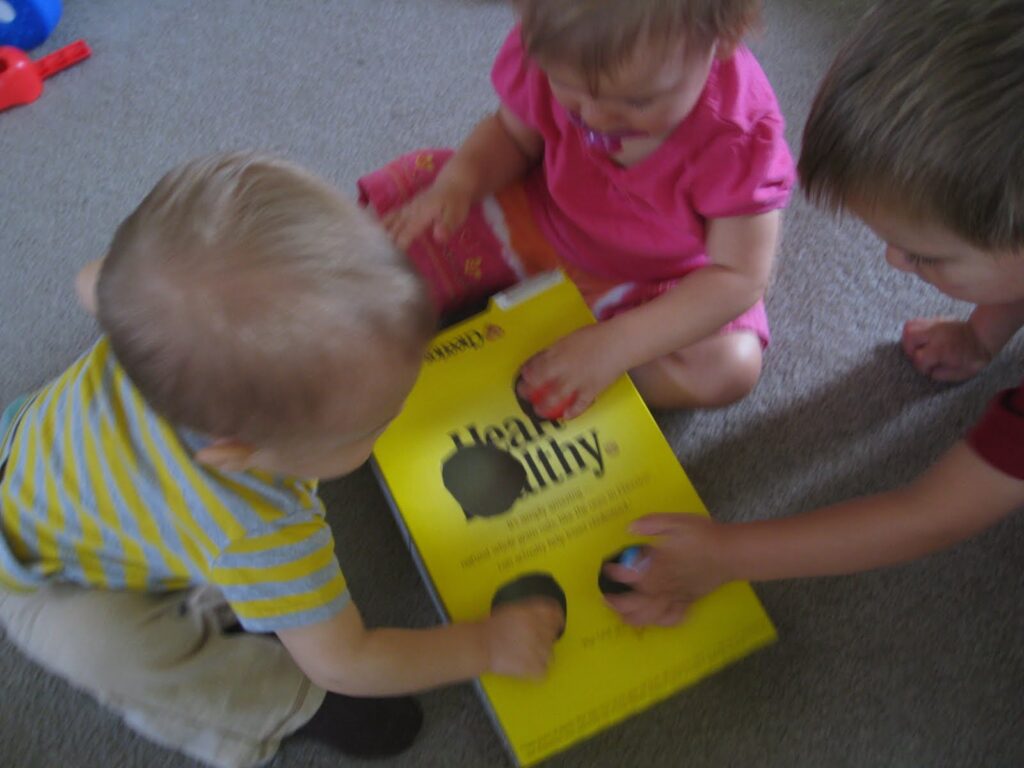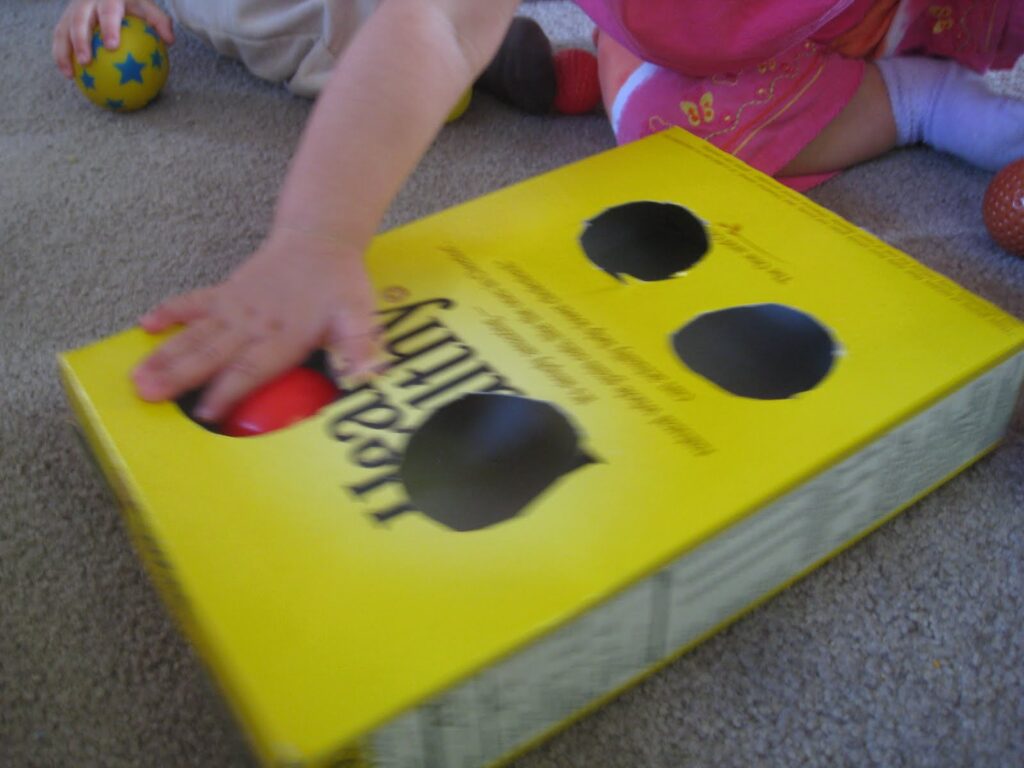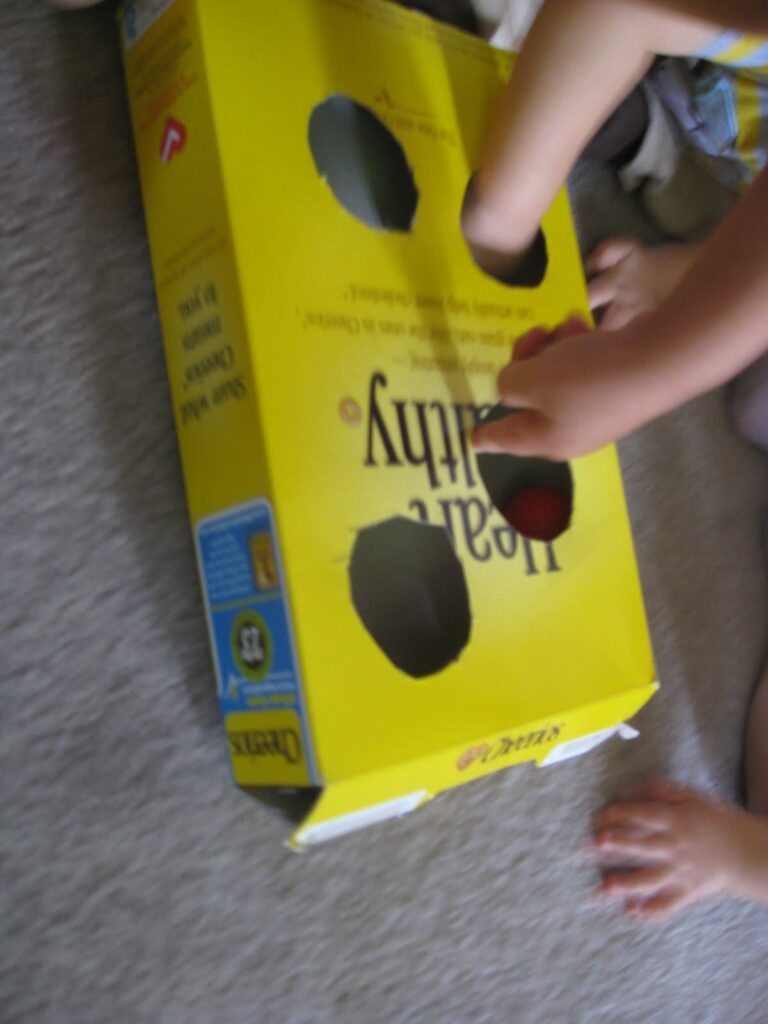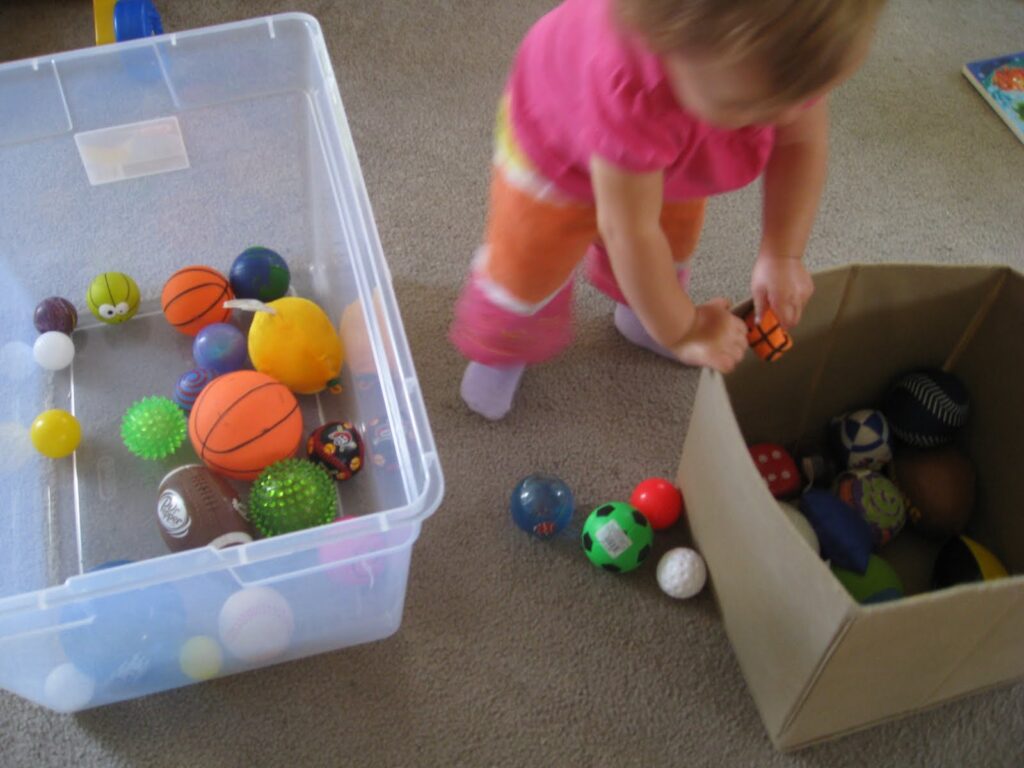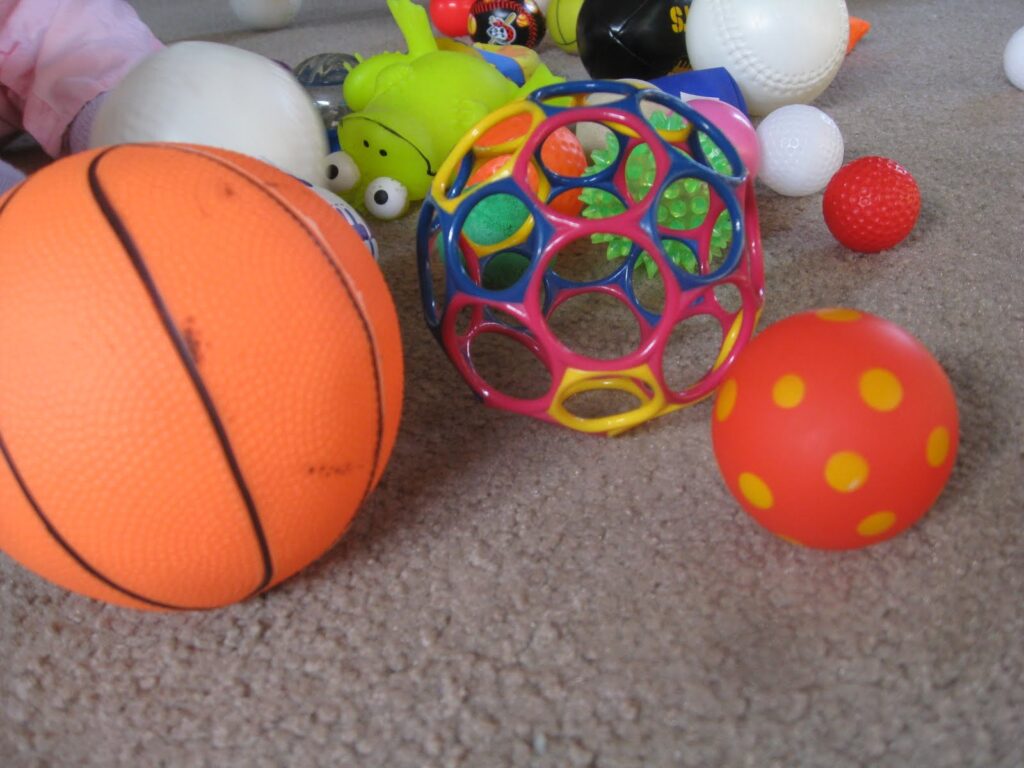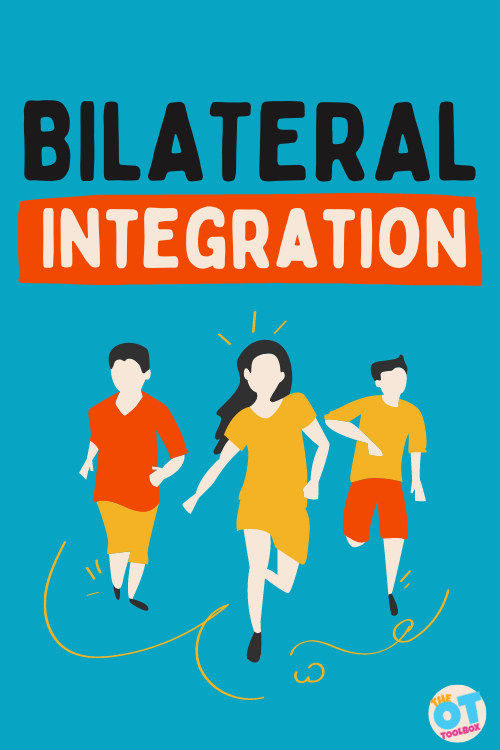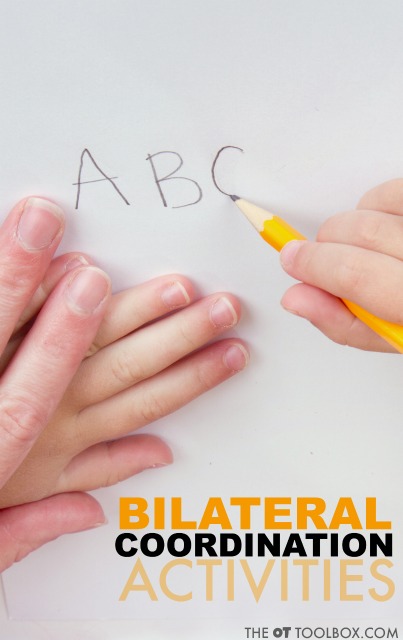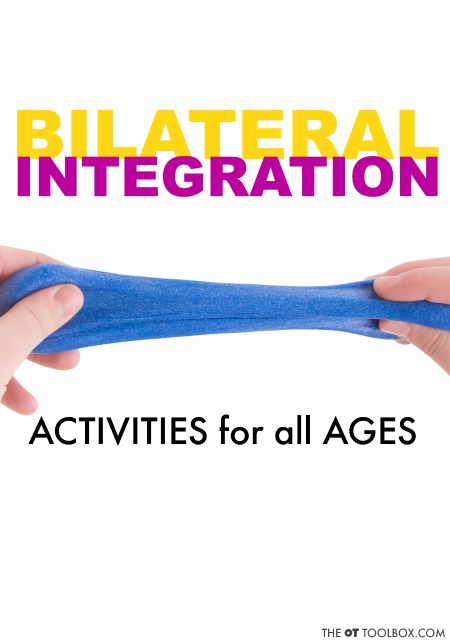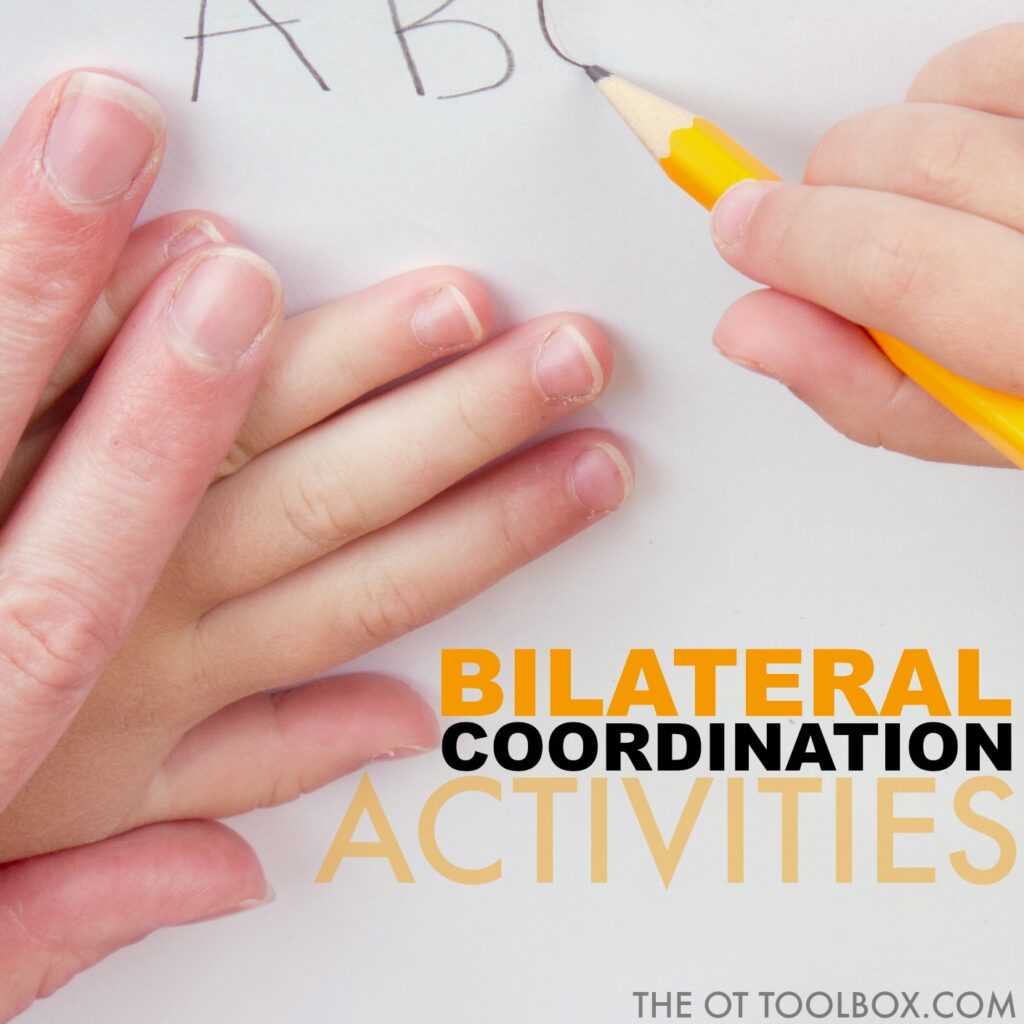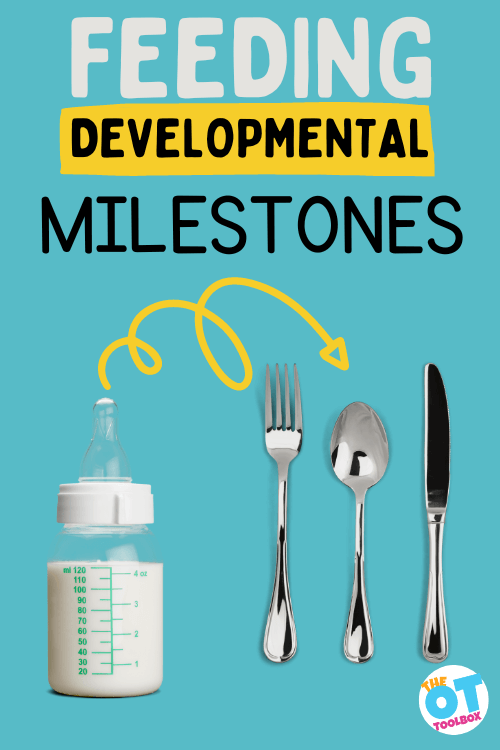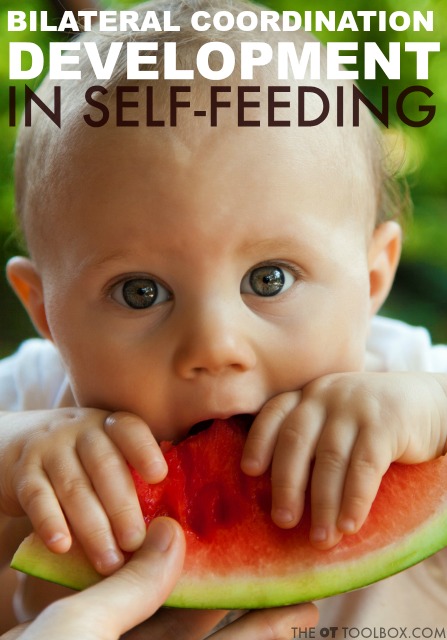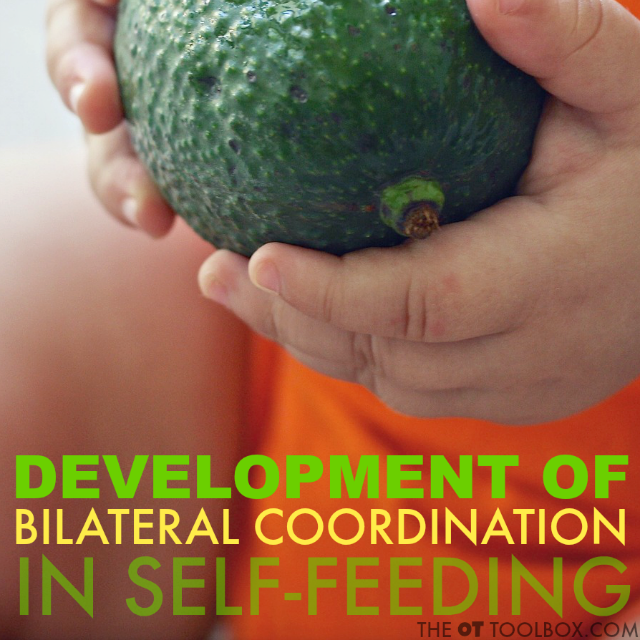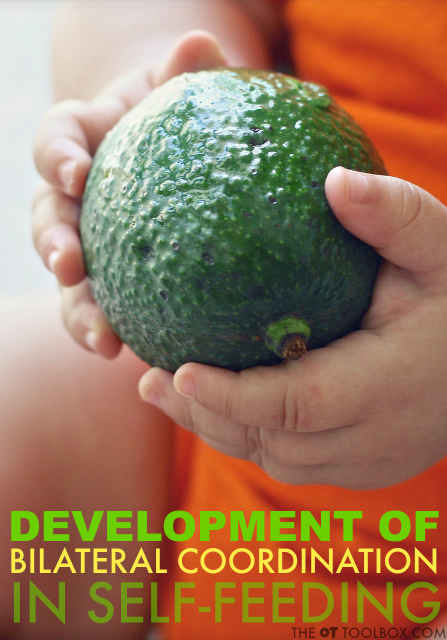Below, you will find resources on feeding developmental milestones and information on development of bilateral coordination that are needed for the feeding skills to use both hands together in a coordinated manner. These bilateral coordination milestones are needed for independent feeding skills, so let’s break this down.
Development of bilateral coordination skills is necessary for improved self-feeding in toddlers and improves through the childhood years. Independence with feeding skills is an important part of child development!
Bilateral Coordination Development
When we talk about bilateral coordination development, we can also mean bilateral integration. Typically, bilateral coordination skills refer to the physical sensory motor use of both sides of the body in a coordinated and fluid manner.
However, bilateral coordination requires the overarching bilateral integration of the brain hemispheres and takes into consideration the ability to manage all of the functions listed above.
In fact, there are three components of bilateral coordination and these play a role in feeding developmental milestones:
- Symmetrical movements- picking up a bottle with both hands to drink
- Reciprocal movements- Using one hand to pick up food and another to pick up food the next time; we see this with babies and toddlers especially
- Dominant hand/supporting hand movements- Using a knife to stabilize the food and the knife to stab the food. Or, holding a bowl with the supporting hand and the dominant hand to scoop the food from a bowl
Independence with feeding progresses from symmetrical movements to reciprocal movements, to dominant/supporting hand movements.
One way to really take a look at the developmental progress of bilateral coordination skills is through the functional task of feeding using cutlery, or utensils like spoons, forks, and knives and drinking tools: cups, bottles, etc.
When children learn to feed themselves and become more independent with self-feeding tool use with finger foods, utensils, or cups, development of bilateral coordination is one aspect that is necessary.
When we think about self-feeding, problems can arise based on a variety of areas. Upper extremity coordination is one of those aspects that are evaluated and addressed when self-feeding difficulties are present.
When thinking about development of self-feeding, consider the following issues related to bilateral coordination difficulty and try using some of the bilateral coordination activities based on development of bilateral coordination to improve feeding skills.
Related: For several ideas to support bilateral coordination skills while indoors, try our list of Winter Bilateral Coordination Activities that kids will love!
Bilateral Coordination Milestones
Bilateral coordination development begins prior to birth, while in the womb with the physical movements felt by the mother. From there and immediately after birth, bilateral coordination milestones are achieved.
Amazon affiliate links are included in this post.
feeding developmental milestones
Development of bilateral coordination in self-feeding depends greatly on the child’s developmental level. Below, we’ll go through feeding milestones by age.
Development of feeding skills is just one skill that is a great way to to assess and analyze the development of bilateral coordination. Also, development of fine motor skills and visual motor skills have an impact on coordination of the hands in self-feeding.
In one blog post, we covered the skills needed for independence with functional tools, including holding a spoon, scooping with spoons, using forks, and other tools like toothbrushes, hair brushes, etc. That is a good place to start with understanding all of the other areas of development that go into tasks like feeding.
Throughout these ages, oral motor development plays a significant role in the manipulation of foods. Consider how these aspects of oral motor skills impact the developmental progression of feeding skills:
- Rooting
- Sucking
- Swallowing
- Gag reflex
- Tongue movement
- Jaw thrust
- Jaw movements (moving jaw side to side to move food and movement of foods)
- Lip closure during swallow phase of eating and drinking
- Biting into foods
- Tolerating different solid food and liquid consistencies
Development of bilateral coordination occurs at every stage of childhood and can be observed through feeding abilities.
Newborn Feeding Skills
At the newborn stage, primitive reflexes dominate movements. In particular the rooting reflex supports feeding at this age.
Babies aged 0-3 months will root, suckle, and swallow in feeding activities. This stage progresses as vision and motor control develop.
Related to this stage is our resource on the strategies occupational therapists can address when newborns are not sleeping through the night, as sleep impacts routine and feeding schedules.
Feeding milestones 4-6 months
In this stage, development of coordination between the eyes and motor skills are just developing. The child explores with their eyes, hands, and mouth and will start to reach for objects purposely around four months. Accuracy of hand use is limited.
Babies can be observed using both hands in play as they pick up objects in their line of sight. However, they typically will pick up items with the hand that is closest to the object or toy.
During this phase, the baby is spoon fed and when presented with a spoon, makes a suckling movement with lips and mouth. The baby will show a gag reflex at this age. With foods on a spoon, the baby will thrust their tongue out at the presence of foods and push the spoon away at times.
Look for munching of the jaw, or movements in the jaw indicating a chewing pattern, even though the young child can not chew at this stage.
Feeding Skills at 6-9 Months
At this stage, the child is typically sitting up with or without support. The child’s hands are often times used in grasp with a clenched or a fist-like grasp.
The child will begin to separate the thumb from the rest of the fingers to use a gross grasp on objects. Babies at this stage will typically place everything in their mouth, using both hands together in symmetry.
The child will hold a bottle or cup with assistance, placing both hands on the cup/bottle, but are not able to hold the cup or bottle on their own.
The gag reflex is still present but it is less sensitive to foods and utensils.
The baby has a voluntary bite on soft foods, chew cookies, and baby teething foods. They will begin to hold those items independently using both hands together at their mouth.
You will see a raking motion from the fingers, but this movement is typically not successful in picking up small foods like baby puff snacks. the baby can , however begin to pick up small food pieces using the thumb and the side of the pointer finger to grasp items (not a pincer grasp)
Feeding Skills at 9-12 Months
The child is able to sit upright without support and develops proximal stability, allowing for increased development of distal extremities.
In this stage, babies are developing pincer grasp and thumb and finger opposition skills. This stage brings the ability to hold one object in each hand such as two blocks.
The baby will be able to bring both hands together at the same time. Children will be able to begin finger feeding skills around 9 months as they bring dry cereal foods to their mouth with a scraping motion.
Finger isolation on both hands begins as they poke foods and explore textures with their hands. Children will use both hands to smear food and bring soft foods such as wet foods like a cereal mix or applesauce to their mouth. The child will be able to hold a cup with both hands and bring it to their mouth.
This stage is when we begin to see functional performance related to arch development. As refined motor skills continue, this base will continue to include utensil use.
The child will start to hold a fork and spoon with a gross grasp, or a palmer grasp but without a dominant arm. At this stage, grasp of the spoon occurs with a palmer grasp. The child will not hold the bowl or plate with their non-assisting hand.
You may see the baby begin to take longer sips from a straw while managing the liquid in their mouth to show a true drink. Similarly, with cup use, there is more drinking patterns as a result of the increased jaw control. However, at this age, these drinking skills are with an adult present to hold and remove the cup or straw. The bilateral coordination skills are not present in order to engage the hands either symmetrical coordination or as a dominant hand/supporting hand along with the drinking aspect.
You will start to see more controlled use of the thumb and pointer finger in a true pincer grasp to pick up foods. This occurs between the tip of the thumb and the pointer fingers. The baby at this age can finger feed themselves.
Feeding Skills at 12-15 Months
In this stage, the child begins to dip their spoon into foods. They will have more accuracy with dipping as opposed to scooping foods.
The spoon is held with a digital grasp and the child will likely switch hands while holding the spoon. The child will lift and drink from a cup with one hand.
As toddlers progress in development, they will begin to establish a dominant hand and crossing midline. This ability to utilize a dominant hand and a non-dominant hand in activities indicates a maturation of the brain and lateralization in functional tasks, which is very important for motor planning, directionality, and visual motor skills.
A scooper bowl with suction base (affiliate link) can be help with scooping development and bilateral coordination at this stage.
The child at this age can hold a spoon with a gross grasp or palmer grasp with an inverted wrist. They will dip the spoon in food. The spoon will make it back to the mouth, but typically, the spoon is only touched to the lips. They will not likely remove all of the food from the spoon using their lips at this point. The motion of the spoon is entirely with the shoulder and elbow. The wrist is in one position so that the spoon is dipped into the food upside down. You’ll see increased shoulder abduction in order to get the spoon into the food. The spoon may be upside down in their mouth too.
Read more in a related blog post about how to hold a spoon.
Feeding Skills at 15-18 Months
The child is able to support the bowl with one hand while scooping with a spoon. Children can hold a small cup and pick out pieces of dry cereal or snacks.
Fine motor skills are developing quickly.
Drinking from a cup can move from a sippy cup to a spouted cup. Other young toddlers can drink from a straw. Holding the cup moves from a two handed grasp to a single grasp. You’ll see grasp on the handle of a sippy cup or spouted cup begins to move from a gross grasp to a pincer grasp. This grasp pattern development occurs in this later stage of toddler range because of the weight of the cup/drink.
By the end of this age range, the 18 month child can hold an open cup on their own to pick up, drink, and set the cup back down with just some spilling of the liquid.
Feeding Skills at 18-24 Months
As a child gets closer to two years of age, the variety of foods increases and this allows for greater exposure to textures of foods (mushy, crunchy, etc.) and types of foods (liquids, solid foods, mixed consistency foods).
The child will typically be able to drink from a cup with accuracy and with one hand but with more accuracy and precision. As the child moves toward two years, you can see a desire to drink from an open cup, but the accuracy of motor control and attention skills are not there for this type of cup.
There will be more coordination of the spouted cup or sippy cup and accuracy, with less spillage.
At this stage, the child will use a dominant hand in self-feeding and will begin to supinate the forearm when scooping with a spoon, resulting in greater accuracy. This looks like a typical spoon motion with the wrist, however there will still be a palmer or gross grasp on the spoon.
By two years, the toddler can use the spoon to scoop and feed themselves chunkier or thicker foods such as applesauce, mashed potatoes, etc.
Feeding Skills at 24-36 Months
During this stage, the child’s dominant hand is more established and the child can support with the non-dominant hand with greater accuracy.
There will be greater control of forearm supination so that the palm is facing upward when scooping. Typically, the child is able to self-feed without assistance.
Around 2.5 years, the child can drink from an open cup with one hand. A small, “pixie” cup or slightly larger small cup is great for this. They can also hold the spoon with a “palm up” position on the spoon. This allows for greater accuracy and ability to self feed thinner soups or cereals with milk.
By the end of this stage, around 3 years, the child can use a fork to pierce soft foods and they can brink the fork to their mouth and remove the food using their teeth and lips.
Feeding Skills at 3-4 Years
The child will begin to use a fork with improving accuracy. They can use a straw and hold the cup with one or both hands. They can also hold a cup while drinking from a straw on their own, and without assistance.
The child can use a pitcher to pour water into a cup, demonstrating bilateral coordination with advancement to the dominant hand/assisting hand stage.
The child will use both hands together with improving coordination in self-feeding. At this age, it’s a great time to get kids involved in helping to cook recipes. This experience in the kitchen along with an adult supports development of fine motor, sensory motor, and visual motor skills. Check out these cooking with kids recipes to support these areas.
Feeding Skills at 4-5 Years
Children will be able to use a knife to spread butter or peanut butter with the dominant hand while holding the plate or bread with their non-dominant hand.
Beginning use of child-friendly knives is appropriate. They will press with the knife rather than chopping or slicing.
In this stage, you’ll see a coordinated use of hands, in most cases. At this age, it’s important to expose the preschool child to lots of fine motor play and sensory motor play experiences to support development and exposure to motor activities. These promote development needed for fine motor skills and success in later years in the classroom.
Feeding Skills at 5-6 Years
Children will use a fork and spoon accurately. They will be able to scoop, poke, and stab with a fork using appropriate positioning and without use of the non-dominant hand to support the plate.
The child will begin to use a knife to cut foods.
Feeding Skills 6+ Years
The child will be able to cut meat with a knife with increasing accuracy and ability. As they develop, the child will increase coordination with knife and fork use in a coordinated manner.
Spilling of cups and foods decreases with age and development.
Attention in feeding tasks develops as children progress through the various stages, too. This makes a big difference in accuracy as well.
The video below shows how grasp patterns impact holding a spoon and fork in feeding tasks. This is important because we can promote more independence with self-feeding by implementing simple activities and specific cues to promote a functional grasp on the fork or spoon. If you can’t view this video, check out our video on YouTube: Using a Spoon-3 Activities to Target Grasp Patterns.
Trouble with Feeding Development
It’s important to remember that all children are different and the developmental milestones for feeding tasks listed above are not set in stone. There is always fluidity with development and feeding skills are no different.
If there are skills that seem to be delayed, be sure to reach out to the child’s pediatrician and a pediatric occupational therapist for individualized feeding evaluation and assessment as well as a specific treatment plan based on the individual’s needs.
Some things to consider that may be impacting feeding development include oral motor problems, determining if the feeding development issues are a result of sensory vs. oral motor considerations, or there is a need for specific adaptive feeding equipment.
